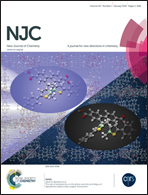Facile one-pot assembly of adhesive phenol/FeIII/PEI complexes for preparing magnetic hybrid microcapsules
Abstract
Magnetic organic–inorganic hybrid microcapsules consisting of plant phenols, polyethylenimine (PEI) and FeIII ion complexes were prepared in a facile one-pot way. Porous CaCO3 microparticles were used as the hard template for the adsorption of negatively charged Fe3O4 nanoparticles, which acted as the source of magnetism for recycling. Moreover, the coated Fe3O4 nanoparticles also helped to improve the rigidness of the microcapsules away from rupturing during multiple reuses. Upon addition of tannic acid (TA), PEI and FeIII ions, the magnetic CaCO3 microparticles were coated with the adhesive complexes through chemical chelation and covalent bonding. Then the template was removed using EDTA to construct the target microcapsules. During the CaCO3 formation step, Candida rugosa lipase (CRL) was used as the biomolecule which was encapsulated in the CaCO3 microparticles. Characterizations demonstrated that the as-prepared magnetic microcapsules showed a robust structure, so that the enzyme inside could be protected physically. As a result, the magnetic hybrid microcapsules exhibited high efficiency in enzyme catalysis and stability against the environment, due to the high biocompatibility and robust structure.


 Please wait while we load your content...
Please wait while we load your content...